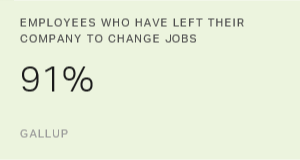Story Highlights
- There are three main perceived barriers to starting a business
- Lack of steady income is the biggest concern
- It takes a village: startups require many resources
Leaders seeking to promote entrepreneurship, take note: Gallup finds that one-quarter of Americans say they've considered becoming business owners but decided not to. For an economy with a negative net number of startups each year since 2008, this represents a missed opportunity to engage would-be entrepreneurs in action that could result in business startups or growth.
Many entrepreneurs lack the expertise or the right set of talents to succeed, which might explain in part why half of the new ventures in the U.S. fail in the first five years. However, startups are essential to economic growth, so supporting prospective entrepreneurs -- the 25% of Americans who've thought about but decided against building a business -- could help them convert their interest into action. To do so, it's crucial to understand these Americans' perceived barriers to entrepreneurship.
Three Main Barriers to Starting a Business
When Gallup asked potential entrepreneurs whether any of seven issues factored into their reasons for choosing not to attempt to start a business, three main barriers emerged.

- Prospective entrepreneurs seek the security and minimal risk associated with working for someone else. For many, wage work with a steady paycheck is more attractive than the risk of starting a company. More than eight in 10 respondents (84%) say the security of a steady income factored into their decision to not start a business. Similarly, two-thirds of respondents (66%) say that worry about the long odds of startup success affected their decision to bypass the entrepreneurial path.
- Potential entrepreneurs don't have enough savings to start a business. About two-thirds of prospective entrepreneurs (68%) see the lack of adequate personal savings as a hindrance to following their entrepreneurial interest. The Wells Fargo/Gallup Small Business Index and Sam's Club/Gallup Microbusiness Tracker find that the majority of business owners fund their early-stage businesses through personal savings. Another recent study by Gallup, analyzing the relationship between personal savings and startup rates, found that the steadily declining personal savings rate in the U.S. has negatively affected prospective entrepreneurs' ability to finance new businesses or secure loans from banks. Thus, it's not surprising that Americans are finding it hard to fund new businesses, given their limited reserves.
- Prospective entrepreneurs see a lack of support for starting a business. Entrepreneurial education and training, whether formal or experiential, are crucial to improving an individual's awareness of the skills and steps necessary for successfully starting a business. But about one-half of potential entrepreneurs (49%) say they have an idea but don't know where to start, and nearly three in 10 say they have no knowledge about running a business (29%). Additionally, 28% say worry about the competition keeps them from starting a business.
Remove Barriers to Business Startup and Convert Interest Into Action
Knowing what keeps potential entrepreneurs from starting a business can help leaders of public and private organizations promote entrepreneurship. To do so, leaders need to remove barriers to starting a business by:
- Increasing access to early-stage startup funding -- New entrepreneurs must determine how to cover expenses while getting started. They need considerable financial support in a startup's early stages before they can access more formal funding from banks or venture capital firms. Recent economic conditions have made lenders more cautious about funding new businesses, so it's harder these days to take the leap into entrepreneurship. Easier access to early-stage funding from seed accelerators, government grants, crowdfunding or angel investors can greatly expedite the process of starting a business for prospective entrepreneurs.
- Providing comprehensive support to those who want to start a business -- Though entrepreneurship fundamentally reflects an individual's vision and effort, it takes a village to launch a business. Startups require numerous resources, talents and expertise to succeed, including funding sources, technical help, business and legal advice, training, and access to co-working spaces. To increase the startup rate, it's imperative to provide potential entrepreneurs access to information about launching a company, running a business, finding mentors and advisers, and procuring space to set up shop and other resources.
- Identifying those who show entrepreneurial aptitude from a young age -- Stage a calculated effort to find young high-potential entrepreneurs and engage them. Offer them education and coaching about what it takes to successfully start, maintain and grow a business. The sooner you can find and educate naturally talented business builders, the earlier you can address the issues that prospective entrepreneurs claim as barriers to starting a business.
Reversing the negative net number of startups in the U.S. depends on discovering and developing potential entrepreneurs by supporting them with the information, tools and experiences they need to succeed.
Survey Methods
Results for this Gallup poll are based on telephone interviews conducted Aug. 29-Sep. 4, 2014, with a random sample of 1,006 adults, aged 18 and older, living in all 50 U.S. states and the District of Columbia. For results based on the total sample of national adults, the margin of sampling error is ±4 percentage points at the 95% confidence level.
Interviews are conducted with respondents on landline and cellular phones. Interviews were conducted in English and Spanish. Each sample of national adults includes a minimum quota of 50% cellphone respondents and 50% landline respondents, with additional minimum quotas by time zone within region. Landline and cellular telephone numbers are selected using random-digit-dial methods. Landline respondents are chosen at random within each household on the basis of which member had the most recent birthday. Samples are weighted to correct for unequal selection probability, nonresponse, and double coverage of landline and cell users in the two sampling frames. They are also weighted to match the national demographics of gender, age, race, Hispanic ethnicity, education, region, population density, and phone status (cell phone only/landline only/both and cell phone mostly). Demographic weighting targets are based on the most recent Current Population Survey figures for the aged 18 and older U.S. population. Phone status targets are based on the most recent National Health Interview Survey. Population density targets are based on the most recent U.S. census. All reported margins of sampling error include the computed design effects for weighting. In addition to sampling error, question wording and practical difficulties in conducting surveys can introduce error or bias into the findings of public opinion polls.


